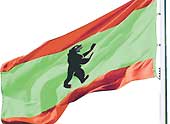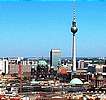5.9 Berlin: Facts and figures
A brief history
 Berlin was founded in the 13th Century and was originally a seat of the Hohenzollerns royal family. It was initially the capital of Brandenburg and then became capital of Prussia, which it remained until 1945. Berlin was also the capital of Germany between 1871 and 1945. From the end of World War II until the reunification of Germany in 1990 the city was divided into two parts: West Berlin (a state of the Federal Republic of Germany, forming an enclave within the German Democratic Republic) and East Berlin (the zone of the city that was Soviet-occupied at the end of the war, and later became capital of the German Democratic Republic). Berlin was founded in the 13th Century and was originally a seat of the Hohenzollerns royal family. It was initially the capital of Brandenburg and then became capital of Prussia, which it remained until 1945. Berlin was also the capital of Germany between 1871 and 1945. From the end of World War II until the reunification of Germany in 1990 the city was divided into two parts: West Berlin (a state of the Federal Republic of Germany, forming an enclave within the German Democratic Republic) and East Berlin (the zone of the city that was Soviet-occupied at the end of the war, and later became capital of the German Democratic Republic).
Despite being blockaded by the Communists, West Berlin was successfully supplied by a large-scale Allied 'airlift' in 1949. A fortified wall separating the two sectors was erected in 1961 by the Communist authorities to curb the flow of refugees to the West, and many people were killed or wounded while attempting to cross.
The Berlin wall was opened in November 1989 after the collapse of the Communist regime in East Germany, and subsequently dismantled. It once more became the capital of Germany after the reunification of October 3, 1990 and the second half of the 1990's witnessed key government bodies relocating from Bonn to Berlin.
The new Berlin
 The new Berlin is defining itself as a bridge between East and West. Berlin is situated on the east-west axis from Paris to Warsaw/Moscow and on the north-south line from Stockholm to Prague, Vienna and Budapest. It has been transformed from the symbol of European division to
the place where East and West Europe meet. The growing economy in Central and Eastern Europe finds a bridge to the western economy in Berlin. Companies with world-wide operations make use of the many institutions located in Berlin and the expertise that is concentrated here. Berlin’s scientific, research and cultural institutions represent one of the invaluable strengths of the city. The new Berlin is defining itself as a bridge between East and West. Berlin is situated on the east-west axis from Paris to Warsaw/Moscow and on the north-south line from Stockholm to Prague, Vienna and Budapest. It has been transformed from the symbol of European division to
the place where East and West Europe meet. The growing economy in Central and Eastern Europe finds a bridge to the western economy in Berlin. Companies with world-wide operations make use of the many institutions located in Berlin and the expertise that is concentrated here. Berlin’s scientific, research and cultural institutions represent one of the invaluable strengths of the city.
Size and population
Berlin currently has a population of 3.45 million inhabitants. It is a multicultural city, with more than 430,000 people from 184 different nations living there. Lower rents for residential accommodation in the eastern boroughs and the greater supply of jobs in the western boroughs led to a new mixture of the population soon after unification. It is both a city and a federal state, fulfils both federal state functions and municipal functions.
 Berlin has an area of around 891 square kilometres - as large as Munich, Stuttgart and Frankfurt am Main put together – and unites a large number of urban districts, centres and boroughs which are completely different in character. In the inner part of the city, the buildings of the Kulturforum on the southern edge of the Tiergarten and the modern office and shopping complex on Potsdamer Platz link the western city around the Kurfürstendamm with the eastern city in the historical centre of Berlin between the Brandenburg Gate and Alexanderplatz. To the north of the Tiergarten, the government and parliament buildings are being built in the meander of the River Spree. Berlin has an area of around 891 square kilometres - as large as Munich, Stuttgart and Frankfurt am Main put together – and unites a large number of urban districts, centres and boroughs which are completely different in character. In the inner part of the city, the buildings of the Kulturforum on the southern edge of the Tiergarten and the modern office and shopping complex on Potsdamer Platz link the western city around the Kurfürstendamm with the eastern city in the historical centre of Berlin between the Brandenburg Gate and Alexanderplatz. To the north of the Tiergarten, the government and parliament buildings are being built in the meander of the River Spree.
Architecture
 In addition to the architecture of the 19th and 20th century, the new cityscape is dominated by buildings designed by top international architects. The outstanding example is the Reichstag, which has been redesigned by Norman Foster and now has a glass dome which is open to visitors. Architects such as Helmut Jahn, Renzo Piano, Hans Kollhoff and Richard Rogers have designed offices, shops and apartments in the restored Potsdamer Platz. Frank O’Gehry has designed a new building on Pariser Platz for the DG Bank and Aldo Rossi's residential complex in the Schützenstraße has also attracted positive comment. In addition to the architecture of the 19th and 20th century, the new cityscape is dominated by buildings designed by top international architects. The outstanding example is the Reichstag, which has been redesigned by Norman Foster and now has a glass dome which is open to visitors. Architects such as Helmut Jahn, Renzo Piano, Hans Kollhoff and Richard Rogers have designed offices, shops and apartments in the restored Potsdamer Platz. Frank O’Gehry has designed a new building on Pariser Platz for the DG Bank and Aldo Rossi's residential complex in the Schützenstraße has also attracted positive comment.
1. Find out more about Berlin!
2. Berlin Newspapers
3. Berlin Listings Magazines
4. Berlin Radio Stations
 |
Web Links |
 |
| General Internet sites about Berlin |
 |
Berlin - Past and Present |
An overview of the history of the city of Berlin. In English. |
 |
Berlin Airlift |
An overview of the Berlin Airlift. |
 |
Potsdamer Platz WebCam |
Live pictures from a WebCam positioned at the newly redeveloped Potsdamer Platz in Berlin. |
 |
Berlin Wall |
See the remains of the Berlin Wall in these panoramic pictures taken by Helmut Koelbach. |
 |
Mauermuseum |
Find out more about the building and the fall of the Berlin Wall. |
|
 Chapter 5.10: History - President Kennedy in Berlin Chapter 5.10: History - President Kennedy in Berlin

 Print This Page Print This Page
|